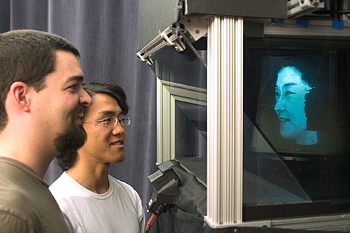SIGGRAPH Continues to Push Boundaries
NEW ORLEANS
Really, where else can you find a studious discussion on pluripotent structures, coupled with demonstrations from a Japanese robot whose sole job is to fold your shirt?
The answer is SIGGRAPH, the conference on computer graphics and interactivity that combines the otherworldly with the cutting edge to create a conference that gives the world a glimpse of what the future has in store.
New Orleans will play host to SIGGRAPH 2009, Aug. 3-7 as the convention tackles the increasing scope of the SIGGRAPH realm, which in recent years has expanded to include gaming, generative fabrication and human-computer interaction as well as the more traditional territory of computer animation and graphics. "Each year, the content presented at SIGGRAPH provides an opportunity to view the best technological breakthroughs and advancements in multiple fields," said Ronen Barzel, SIGGRAPH 2009 conference chair. "In no other environment is there such a high caliber of computer graphics and interactive content provided."
An expected 20,000 professionals are expected to descend on the Ernest N. Morial Convention Center as the conference celebrates its 36-year anniversary.

Among the highlights at SIGGRAPH is HeadSPIN, a 3D video teleconferencing system that enables realistic eye contact between a three-dimensionally transmitted subject and individuals in a conference room.NEW MUSIC TRACK
This year the convention is branching out into new areas, and as with most of the new segments introduced into SIGGRAPH, the goal is to introduce the entire breadth of the medium to attendees. New this year is a gaming and digital music track that will showcase research in visual music, innovative synthesis methods and art installations to showcase and question common assumptions about the challenges facing game designers and players.
Apparently, if you thought there was little academic forethought behind today's slate of video games, think again. As part of SIGGRAPH's expanded focus on video gaming, the festival will dedicate a segment to real-time rendering projects, making "this one of the most dynamic and innovative festivals in SIGGRAPH history," Barzel said.
And yes, playing will be an integral part of the convention. SIGGRAPH will host a videogame competition called "GameJam" with teams of three competing for a consecutive 24 hours in a row to create, design and implement a comprehensive game. Perplexing though it may be to seasoned engineers from other professional mediums, the game portion of SIGGRAPH represents significant real-world achievements.
"SIGGRAPH's expanded focus into the videogame arena offers a great opportunity for a competition to bring some experimental gameplay into the mix," said Drew Davidson, director of interactive play. And for those cynics looking for a little humor in the situation: yes, there will be an award handed to the worst project, known painfully as the "Epic Failure."
To recognize the growth of video games in today's culture, SIGGRAPH will welcome virtual world developer Will Wright as keynote speaker. As creator of "Spore" and "The Sims" series of virtual character creation, Wright serves as an example of how the burgeoning video game industry has pervaded our culture to become an art medium in its own right.
COMPUTER ANIMATION
The highlight for many at SIGGRAPH is often the Computer Animation Festival, which was expanded in 2008 to include public access, presentations and panels that focus on the art, science and technology used to create digital cinema and visualizations. This year, the festival will also branch out to include visual music and real-time rendering as well as presentations on the creative, scientific and technical process of creating films.
SIGGRAPH isn't simply about the flash and dazzle of an interactive art installation or a six-foot-tall plastic lantern. The festival pushes the boundaries of what viewers have come to expect in all fields of real-time rendering, be that a best-selling video game, applications for medicine or in the field of astrophysics.
Likewise, the festival's focus on visual music is designed to stretch from the academic to the midst of urban pop culture. "Incorporating a larger focus on music and real-time rendering in animation makes the festival a truly comprehensive example of the computer graphics industry," said Carlye Archibeque, Computer Animation Festival executive producer. "Real time engines and visuals that interact with music are creating some of the most amazing graphics available today."
From the music space, sound engineer Randy Thom will touch on his experiences in a second keynote address. As the director of sound design for Skywalker Sound, Thom worked on films like "Forrest Gump," "Ratatouille" and the Harry Potter series. In addition, Steve Duenes, a graphics director for the New York Times, and Academy Award winner Chris Landreth will discuss the "Uncanny Valley" effect: the unintended consequence of making CGI characters too realistic.
SIGGRAPH is also expanding into other alternative fields, including robotics, input interfaces, haptics and experimental sensory experiences. Through demonstrations and interactive installations, attendees will see "how technology and computer graphics might soon be enhancing the average person's everyday work and life," said Manabu Sakurai, Emerging Technologies chair.
The technologies on display are designed to help those with physical challenges as well as improve the entertainment experience with technologies like sound scope headphones that let users control an audio mixer through their dance movements, or HeadSPIN, a 3D video teleconferencing system that enables realistic eye contact between a three-dimensionally transmitted subject and individuals in a conference room. Like a robotic version of yourself, the system can reproduce the effects of gaze, rapt attention and eye contact to take teleconferencing to a much more personal level.
Get the TV Tech Newsletter
The professional video industry's #1 source for news, trends and product and tech information. Sign up below.
Susan Ashworth is the former editor of TV Technology. In addition to her work covering the broadcast television industry, she has served as editor of two housing finance magazines and written about topics as varied as education, radio, chess, music and sports. Outside of her life as a writer, she recently served as president of a local nonprofit organization supporting girls in baseball.

